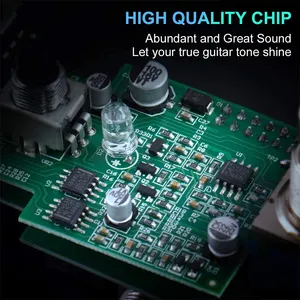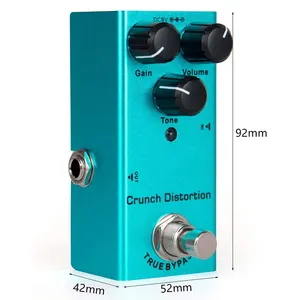Introduction to Multi Effect Guitar Processor
A multi effect guitar processor is a revolutionary piece of equipment designed for guitarists who seek versatility and creativity in their music. This device combines multiple effects and amp simulations into a single unit, allowing musicians to easily shape their sound and explore various tonal possibilities. Ideal for both live performances and studio recording, a multi effect guitar processor caters to all levels, from beginners to professional musicians, making it an essential tool for anyone looking to enhance their guitar experience.
Types of Multi Effect Guitar Processor
Multi effect guitar processors come in various forms to suit different playing styles and requirements. Here are the most common types:
- Pedal Board Multis: These are standalone units that can be integrated into a pedal board setup, allowing for easy access to effects during performances.
- Rackmount Units: Designed for professional studio setups, these processors are mounted in a rack and provide extensive processing capabilities for complex sound creation.
- Stompbox Style: Compact and portable, these smaller units are perfect for musicians on the go, providing essential effects without taking up much space.
- DAW Integration Models: These processors connect seamlessly with Digital Audio Workstations, enabling in-depth editing and sound manipulation with software.
Function, Feature, and Design of Multi Effect Guitar Processor
Understanding the functions and features of a multi effect guitar processor is vital for selecting the right unit for your needs. Here are the critical functions and standout features to consider:
- Effect Variety: Includes distortions, delays, reverbs, modulation effects, overdrive, and more, providing countless sonic possibilities for every genre.
- Presets: Most processors come pre-loaded with a library of sound presets, allowing users to select and switch between different sounds easily.
- Customizability: Users can create and save personalized effects chains to suit their specific sound requirements, ensuring a unique musical identity.
- User Interface: A range of interfaces—from LCD screens to tactile buttons—ensures easy navigation and fine-tuning of settings.
- Built-In Tuner: Many models include an integrated tuner, adding convenience during live performances and practice sessions.
Applications of Multi Effect Guitar Processor
Multi effect guitar processors serve a myriad of applications across different environments, showcasing their versatility:
- Live Performances: These units allow guitarists to switch between multiple effects effortlessly, adapting their sound for different songs within a set.
- Recording: In the studio, musicians can experiment with various sound combinations and effects in real-time, facilitating creative production processes.
- Practice: Guitarists can use these processors to enhance their practice sessions by adding effects that improve their techniques and motivate their creativity.
- Collaborative Projects: The flexibility of sound design helps musicians from different genres collaborate seamlessly, exchanging ideas and tones effortlessly.
Advantages of Using Multi Effect Guitar Processor
Investing in a multi effect guitar processor offers numerous advantages that contribute to a guitarist's overall experience:
- Space-Saving: Replacing multiple individual pedals, these processors save valuable space on stage or in a studio.
- Cost-Effective: Purchasing a single unit with diverse capabilities can often be more affordable than acquiring several separate effects pedals.
- Consistency: Using a processor provides consistent effects quality from gig to gig, ensuring your sound remains true no matter where you perform.
- Portability: Most modern processors are lightweight and portable, making them ideal for traveling musicians who require gear that can move with them.
- Innovation: Modern multi effect processors continually evolve with technology, providing users with new sounds and features through firmware updates.








































































































































































































